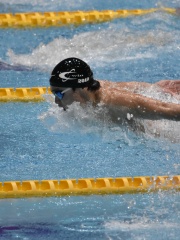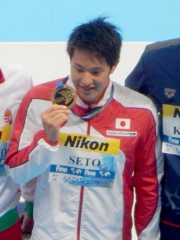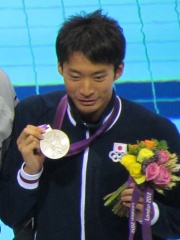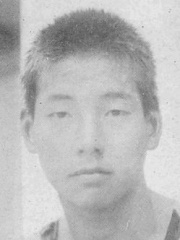
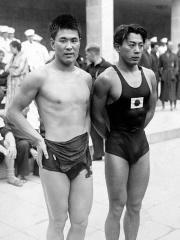
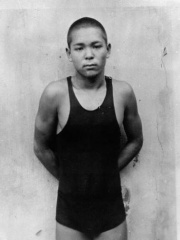
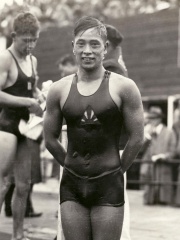
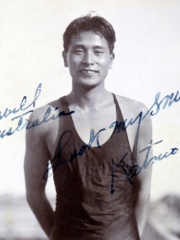
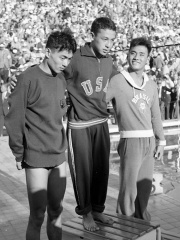
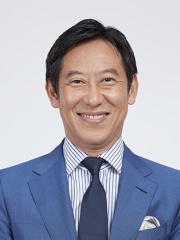
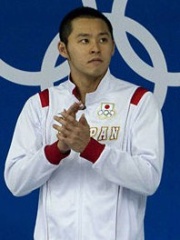
The Most Famous
SWIMMERS from Japan
Top 10
The following people are considered by Pantheon to be the top 10 most legendary Japanese Swimmers of all time. This list of famous Japanese Swimmers is sorted by HPI (Historical Popularity Index), a metric that aggregates information on a biography's online popularity. Visit the rankings page to view the entire list of Japanese Swimmers.

1. Yasuji Miyazaki (1916 - 1989)
With an HPI of 57.75, Yasuji Miyazaki is the most famous Japanese Swimmer. His biography has been translated into 20 different languages on wikipedia.
Yasuji Miyazaki (宮崎 康二, Miyazaki Yasuji) (October 15, 1916 – December 30, 1989) was a Japanese swimmer who competed at the 1932 Summer Olympics in Los Angeles. Miyazaki was born in Kosai, Shizuoka Prefecture, Japan. He was selected for the Japanese Olympic team for the 1932 Los Angeles Olympics at the age of 15, and was one of the youngest members. In the semi-finals of the 100 m freestyle event, he surpassed the Olympic record previously set by American champion Johnny Weissmuller with a time of 58.2 seconds, and won the gold medal. The following day, as part of the team competing in the 4 × 200 m freestyle relay event, he won a second gold medal, with the team setting a new world record of 8 minutes 58.4 seconds. After his return to Japan, he entered Keio University and retired from competitive sports.

2. Shigeo Arai (1916 - 1944)
With an HPI of 57.54, Shigeo Arai is the 2nd most famous Japanese Swimmer. His biography has been translated into 21 different languages.
Shigeo Arai (新井 茂雄, Arai Shigeo; August 8, 1916 – July 19, 1944) was a Japanese freestyle swimmer who competed at the 1936 Olympics. He won a gold medal in 4 × 200 m freestyle relay, setting a world record. In the individual 100 m race, he finished almost simultaneously with Masanori Yusa and Masaharu Taguchi and was awarded a bronze medal. Those Games were the only international competition for Arai, though he won three national titles in the 100 m and four in the 200 m freestyle between 1937 and 1940. While serving in the Imperial Japanese Army during World War II, he was killed in action in Burma.

3. Kusuo Kitamura (1917 - 1996)
With an HPI of 57.40, Kusuo Kitamura is the 3rd most famous Japanese Swimmer. Her biography has been translated into 21 different languages.
Kusuo Kitamura (北村 久寿雄, Kitamura Kusuo; October 9, 1917 – June 6, 1996) was a Japanese swimmer who competed at the 1932 Summer Olympics in Los Angeles, California. Kitamura was born in Kōchi, Japan. Selected as one of the youngest members of the Japanese swimming team in the 1932 Los Angeles Olympics, he won the gold medal in the Men's 1500 meter freestyle swimming event. He was 14 years and 309 days old at the time, setting a record for youngest ever swimmer to win a gold medal at the Olympic Games. This record lasted until the 1988 Summer Olympics in Seoul, Korea, when Hungarian swimmer Krisztina Egerszegi won the gold in the Women's 200-meter backstroke event. However, Kitamaura still holds the record for the youngest male swimmer. After the 1932 Olympics, Kitamura retired from competitive sports, and eventually graduated from Tokyo Imperial University, and obtained a job at the Japanese Ministry of Labor. He rose through the bureaucratic ranks, eventually becoming a department head, before retiring in 1984 to become a director at Sumitomo Cement.

4. Yoshiyuki Tsuruta (1903 - 1986)
With an HPI of 54.74, Yoshiyuki Tsuruta is the 4th most famous Japanese Swimmer. His biography has been translated into 20 different languages.
Yoshiyuki Tsuruta (鶴田 義行, Tsuruta Yoshiyuki) (October 1, 1903 – July 24, 1986) was a Japanese swimmer. He won a gold medal in the Amsterdam Olympics and the Los Angeles Olympics.
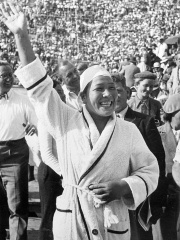
5. Hideko Maehata (1914 - 1995)
With an HPI of 53.57, Hideko Maehata is the 5th most famous Japanese Swimmer. Her biography has been translated into 20 different languages.
Hideko Maehata (前畑 秀子, Maehata Hideko; May 20, 1914 – February 24, 1995) was a Japanese breaststroke swimmer and the first Japanese woman to earn a gold medal in the Olympics. Maehata was born in Hashimoto, Wakayama, as the daughter of a tofu producer and as a child learned to swim in the Kinokawa River. In the fifth grade of elementary school, she set an unofficial youth record for the 50-meter breaststroke. She went on to win numerous competitions, and was sponsored to attend a women’s boarding school in Nagoya which specialized in swimming, but the sudden death of her parents in 1931 forced her to return home. Yet she was selected for the Japanese Olympic swimming team for the 1932 Summer Olympics in Los Angeles, and won the silver medal in the 200 m breaststroke event. She lost to Clare Dennis a mere 0.1 of a second. During the post-Olympic celebration after her return to Japan, she stated that she was considering to retire from competitive swimming due to family issues, but then Tokyo mayor Hidejirō Nagata reportedly asked her why she did not bring back a gold medal. Over the next four years, Maehata trained very hard, and set a new world record for the 200-meter breaststroke on September 30, 1933. During the 1936 Berlin Olympics, Maehata competed in a dead heat against the reigning German national champion, Martha Genenger, winning the gold medal for the Women's 200 m breaststroke by over one second. Despite the time difference, the race was broadcast live in Japan by NHK Radio. In 1937, Maehata married Masahiko Hyodo, a professor of the medical school of Nagoya University, and retired from competition. She was awarded the Purple Ribbon of Merit by the Japanese government in 1964 and inducted into the International Swimming Hall of Fame in 1979. She had a cerebral hemorrhage in 1983, which killed both her parents, but recovered. In 1990 she was designated a Person of Cultural Merit, the first sportswoman in Japan to receive such an honor. She died of acute renal failure in 1995.

6. Katsuo Takaishi (1906 - 1966)
With an HPI of 52.08, Katsuo Takaishi is the 6th most famous Japanese Swimmer. His biography has been translated into 17 different languages.
Katsuo Takaishi (高石 勝男, Takaishi Katsuo; October 14, 1906 – April 13, 1966) was a Japanese swimmer, swimming coach and sports administrator. Takaishi was born in Osaka and graduated from Waseda University. During the 1923 Far Eastern Games held in Osaka, he won all three freestyle swimming events, which secured him a place on the Japanese Olympic team. At the 1924 Olympics, Takaishi placed fourth in the 4 × 200 meter freestyle relay and fifth in the 100 m freestyle and in the 1500 m freestyle event. Although he did not win a medal, it was the first time that a swimmer from Asia finished next to the podium. From 1924 to 1928, Takaishi won every international competition he attended, except when racing against Johnny Weissmuller. At the 1928 Olympics, as the leader of the Japanese swimming team, Takaishi won a silver medal in the 4 × 200 m freestyle relay and a bronze medal in the 100 m freestyle, becoming the first Asian to win an Olympic medal in swimming. He finished fourth in a 400 m semifinal and thus did not advance to the final. At the 1932 Olympics in Los Angeles Takaishi served as team captain and coach for the Japanese team, which won all men's events save one. After his return to Japan, he wrote a book, Swimming in Japan, which was published in 1935. He served as general director of the Japanese national swimming team for the 1964 Summer Olympics in Tokyo, and was chairman of the Amateur Swimming Federation of Japan. Takaishi died of lung cancer at the age of 59. He was posthumously honored with induction into the International Swimming Hall of Fame in 1991.

7. Shiro Hashizume (1928 - 2023)
With an HPI of 51.04, Shiro Hashizume is the 7th most famous Japanese Swimmer. His biography has been translated into 17 different languages.
Shiro Hashizume (橋爪四郎, Hashizume Shirō; September 20, 1928 – March 9, 2023) was a Japanese Olympic freestyle swimmer. He won the silver medal in the men's 1500m freestyle at the 1952 Summer Olympics in Helsinki, Finland. He broke the world record in the same event on August 16, 1949, clocking 18:35.7. That time was bettered the same day, however, by compatriot Hironoshin Furuhashi at the American Swimming Championships in Los Angeles, California.

8. Daichi Suzuki (b. 1967)
With an HPI of 44.89, Daichi Suzuki is the 8th most famous Japanese Swimmer. His biography has been translated into 20 different languages.
Daichi Suzuki (鈴木 大地, Suzuki Daichi) (born March 10, 1967, in Narashino, Chiba) is a retired Japanese backstroke swimmer. He won a gold medal at the 1988 Summer Olympics in Seoul. Japan's First Chief Commissioner of Sports Agency (2015 - 2020). Chair of Japan Swimming Federation (2013 - 2015, 2021 - ). Vice President of Asia Aquatics (2016 - ). Bureau Member of World Aquatics (2017 - ). Professor and Associate Dean, Faculty of Health and Sports Science at Juntendo University.

9. Kosuke Kitajima (b. 1982)
With an HPI of 44.15, Kosuke Kitajima is the 9th most famous Japanese Swimmer. His biography has been translated into 26 different languages.
Kosuke Kitajima (北島 康介, Kitajima Kōsuke; born September 22, 1982) is a Japanese retired breaststroke swimmer. He won gold medals at the men's 100 m and 200 m breaststroke events at the 2004 Summer Olympics, and the 2008 Summer Olympics – becoming the first and only swimmer to sweep the breaststroke events at consecutive Olympic games.
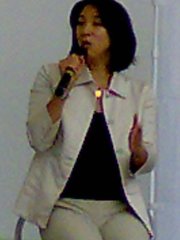
10. Mikako Kotani (b. 1966)
With an HPI of 43.36, Mikako Kotani is the 10th most famous Japanese Swimmer. Her biography has been translated into 14 different languages.
Mikako Kotani (小谷 実可子, Kotani Mikako; born 30 August 1966) is a Japanese former synchronized swimmer who competed in the 1988 Summer Olympics, where she gained a bronze medal each for the solo and duet events, and the 1992 Summer Olympics. She was the first woman to be Japan's flag-bearer for the 1988 Summer Olympics Opening Ceremony.
People
Pantheon has 62 people classified as Japanese swimmers born between 1903 and 2005. Of these 62, 55 (88.71%) of them are still alive today. The most famous living Japanese swimmers include Daichi Suzuki, Kosuke Kitajima, and Mikako Kotani. The most famous deceased Japanese swimmers include Yasuji Miyazaki, Shigeo Arai, and Kusuo Kitamura. As of April 2024, 22 new Japanese swimmers have been added to Pantheon including Mikako Kotani, Miwako Motoyoshi, and Akiko Kawase.
Living Japanese Swimmers
Go to all RankingsDaichi Suzuki
1967 - Present
HPI: 44.89
Kosuke Kitajima
1982 - Present
HPI: 44.15
Mikako Kotani
1966 - Present
HPI: 43.36
Miwako Motoyoshi
1960 - Present
HPI: 43.03
Akiko Kawase
1971 - Present
HPI: 40.58
Junko Tanaka
1973 - Present
HPI: 40.03
Ai Shibata
1982 - Present
HPI: 39.27
Kosuke Hagino
1994 - Present
HPI: 38.35
Yoko Isoda
1978 - Present
HPI: 38.03
Emiko Suzuki
1981 - Present
HPI: 37.64
Daiya Seto
1994 - Present
HPI: 37.59
Ryosuke Irie
1990 - Present
HPI: 37.52
Deceased Japanese Swimmers
Go to all RankingsYasuji Miyazaki
1916 - 1989
HPI: 57.75
Shigeo Arai
1916 - 1944
HPI: 57.54
Kusuo Kitamura
1917 - 1996
HPI: 57.40
Yoshiyuki Tsuruta
1903 - 1986
HPI: 54.74
Hideko Maehata
1914 - 1995
HPI: 53.57
Katsuo Takaishi
1906 - 1966
HPI: 52.08
Shiro Hashizume
1928 - 2023
HPI: 51.04
Newly Added Japanese Swimmers (2025)
Go to all RankingsMikako Kotani
1966 - Present
HPI: 43.36
Miwako Motoyoshi
1960 - Present
HPI: 43.03
Akiko Kawase
1971 - Present
HPI: 40.58
Junko Tanaka
1973 - Present
HPI: 40.03
Yoko Isoda
1978 - Present
HPI: 38.03
Emiko Suzuki
1981 - Present
HPI: 37.64
Kanako Kitao
1982 - Present
HPI: 37.01
Raika Fujii
1974 - Present
HPI: 36.66
Juri Tatsumi
1979 - Present
HPI: 35.38
Saho Harada
1982 - Present
HPI: 35.08
Yasuko Tajima
1981 - Present
HPI: 34.15
Mai Nakamura
1989 - Present
HPI: 32.86
Overlapping Lives
Which Swimmers were alive at the same time? This visualization shows the lifespans of the 3 most globally memorable Swimmers since 1700.





